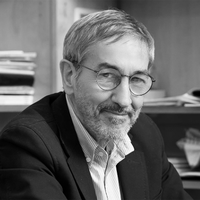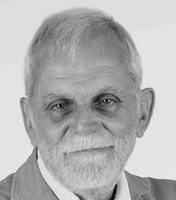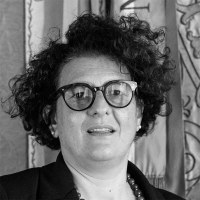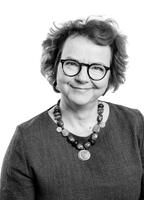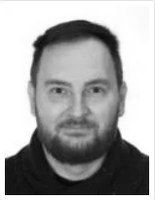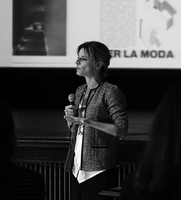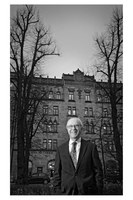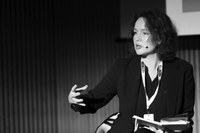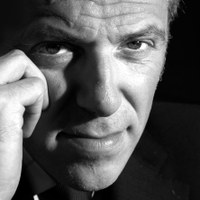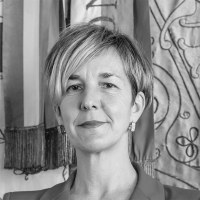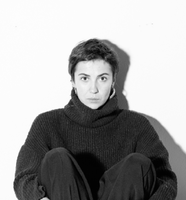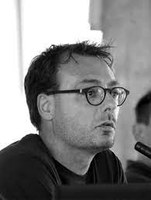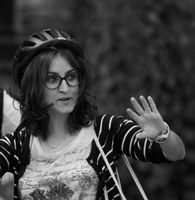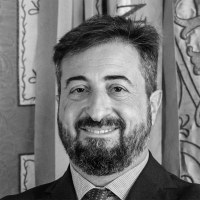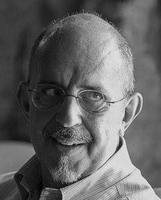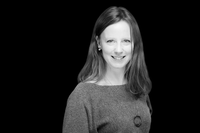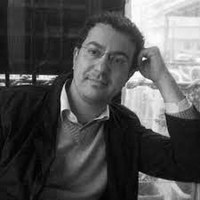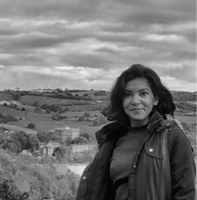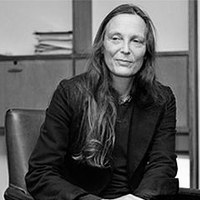Roberto Di Giulio
full professor, Department of Architecture, University of Ferrara
Roberto Di Giulio is an architect, PhD in "Architecture Technology", full professor at the Department of Architecture, University of Ferrara, where he has been the Dean from 2012 to 2018.
He is the CEO and Scientific Director of the spin-off INCEPTION, an innovative start-up incubated at the University of Ferrara that he founded after coordinating the INCEPTION project "Inclusive Cultural Heritage in Europe through 3D semantic modeling", funded by the European Commission within the Reflective 7 - Horizon 2020 program.
He is the Scientific Coordinator of “4CH - Competence Centre for the Conservation of Cultural Heritage” the ongoing research project funded by the European Commission to set up the European Competence Centre for preservation and conservation of Monuments and Sites.
His research activities cover a broad range of issues including studies of materials performances and building design methodologies, innovative technologies and design methodologies for Cultural Heritage conservation and restoration, maintenance strategies and building pathology applied to the historic and contemporary buildings.
Heritage and Crises in the Digital Age
13.30 - 15.00 | Session 1: HERITAGE AND CRISES (Keynote speaker)
Actions aimed at preserving social and identity values can make a significant contribution to positively steering transformation processes triggered by crises. Safeguarding and enhancing the tangible and intangible assets of the Cultural Heritage, a precious witness to these values, are part of these actions and can give substance to the relationship, so often recalled in recent years, between crisis and opportunity.
The implementation of digital technologies has been a feature of many of the most important socio-economic changes of the last two decades and has introduced significant transformations also in the field of Cultural Heritage.
Information and Communication Technologies played a key role in the pandemic years, during which all activities related to the Cultural Heritage sector were seriously affected by restrictions that in many cases limited – or more often completely closed down - access and enjoyment of monuments and sites.
The digital transition had already been underway for some time with objectives focused on the preservation and protection of heritage sites increasingly exposed to risks from natural, climatic and anthropogenic factors.
In the last few years (partly as a consequence of the pandemic crisis), new ways of perceiving, communicating and enjoying Cultural Heritage have also become objectives to be achieved through digitisation.
To achieve these objectives, it is crucial to strengthen cooperation between digital and physical infrastructures and to create transnational networks for the sharing and dissemination of technologies, services and products for the conservation of Cultural Heritage
The 4CH project (https://www.4ch-project.eu/), aiming at the creation of the European Competence Centre for the Conservation of Cultural Heritage, is moving in this direction.
The strategic role of the Competence Centre will be to federate European Institutions working in the field of Cultural Heritage and to cooperate in the implementation of a common Data Space ensuring interoperability and accessibility of digitised heritage assets.
Franco Niccolucci
Direttore, VAST-LAB, PIN, Prato
Franco Niccolucci is the director of VAST-LAB research laboratory at PIN in Prato, Italy. A former professor at the University of Florence until 2008, he has directed the Science and Technology in Archaeology Research Center (STARC) at the Cyprus Institute, Nicosia, until 2013. Prof Niccolucci has coordinated several EU-funded projects on the applications of Information Technology to Cultural Heritage, and is currently the coordinator of ARIADNEplus, a research infrastructure on archaeological data, and director for technology in 4CH, a project to create a European Competence Centre on Cultural Heritage. His main research interests concern knowledge organization of heritage documentation and the valorisation of cultural heritage. He is currently the Editor-in-Chief of JOCCH, the ACM Journal of Computing and Cultural Heritage. He has authored about 100 papers and book chapters.
Smart cities and digital twins
13.30 - 15.00 | Session 1: HERITAGE AND CRISES
The concept of smart city as a city that avails of advanced information technology to collect real-time information on the processes that happen in the urban environment, to simulate the effects of interventions on such processes according to pre-defined schemas, and to manage accordingly the services provided to citizens, is now more than ten years old. Nevertheless, the debate is still open on its critical aspects, among others on those concerning privacy, the prevalence of a technology-driven approach instead of a community-based one, and the potential increase of the divide between different categories of citizens not corresponding to the pre-determined global model on which the smart management is based. On the other hand, information technology is nowadays a pervasive factor of everyday life, and correcting its degenerations is the current approach adopted to protect privacy, to guarantee inclusion, and contrast excesses deriving from misuse. In this short presentation we will start from the consideration that the transparency and public awareness of the model adopted to obtain smartness is the first step to avoid, or at least mitigate, the adverse effects of excessive automation, still retaining its advantages, deriving from the potential beneficial effects of being smart on the quality of life, on the environment and in general to the well-being of citizens. For this, we will briefly analyse the concept of the digital twin of a city as a prerequisite to its smartness to foster the transparency of the underlying conceptual model. This includes considering which data are collected and how they are organized, how real processes are simulated, and how the outcomes of such simulation lead to intervention on the real world. In this way we will point out how this approach may well extend from the built environment to the urban one.
Paola Ronzino
Senior Researcher VAST-LAB, PIN S.C.r.L.
Paola Ronzino is a researcher in ICT applied to cultural heritage, with a PhD in Science and Technologies for Cultural Heritage and a degree in Archaeology. Her research concerns the development of ontologies and metadata schemas for archaeological and architectural heritage documentation, with particular interest on the documentation of the buildings archeology. She has participated in several research projects concerning ICT for Cultural Heritage, cultural semantics and digital libraries and is currently involved in the ARIADNEplus and 4CH project.
Smart cities and digital twins
13.30 - 15.00 | Session 1: HERITAGE AND CRISES
The concept of smart city as a city that avails of advanced information technology to collect real-time information on the processes that happen in the urban environment, to simulate the effects of interventions on such processes according to pre-defined schemas, and to manage accordingly the services provided to citizens, is now more than ten years old. Nevertheless, the debate is still open on its critical aspects, among others on those concerning privacy, the prevalence of a technology-driven approach instead of a community-based one, and the potential increase of the divide between different categories of citizens not corresponding to the pre-determined global model on which the smart management is based. On the other hand, information technology is nowadays a pervasive factor of everyday life, and correcting its degenerations is the current approach adopted to protect privacy, to guarantee inclusion, and contrast excesses deriving from misuse. In this short presentation we will start from the consideration that the transparency and public awareness of the model adopted to obtain smartness is the first step to avoid, or at least mitigate, the adverse effects of excessive automation, still retaining its advantages, deriving from the potential beneficial effects of being smart on the quality of life, on the environment and in general to the well-being of citizens. For this, we will briefly analyse the concept of the digital twin of a city as a prerequisite to its smartness to foster the transparency of the underlying conceptual model. This includes considering which data are collected and how they are organized, how real processes are simulated, and how the outcomes of such simulation lead to intervention on the real world. In this way we will point out how this approach may well extend from the built environment to the urban one.
Marco Pretelli
Full Professor in Conservation and Restoration of Architecture Departement of Architecture, Alma Mater Studiorum Università di Bologna
PhD in Architectural Conservation. Formerly an architectural officer at the Soprintendenze ai Beni Architettonici e al Paesaggio in Arezzo (2000) and Venice and Lagoon (2000-2005), since 2016 he has been full professor in Architectural Restoration at the Department of Architecture of the University of Bologna. He has been a member (2010-2013) of the Board of the Doctorate in Preservation of Architectural Heritage at Politecnico di Milano and since 2013 he is member of the Doctorate Board in Architecture and Cultures of Design at its Department. He is currently part of the scientific committee of the association ATRIUM-Architecture of Totalitarian Regimes of XX Century in Urban Managements, recognised as a cultural route by the Council of Europe. He was scientific advisor to Fondazione CaRiPLo for the call "Beni al sicuro "dedicated to the cultural heritage at risk (2018-2021). As part of his Superintendence activities, he has designed and directed restoration sites for important buildings in the Venice Lagoon. The main lines of research focus on topics of theory and history of restoration; restoration of Modern Architecture; restoration of historical plant; microclimate of the historic architecture. He has acted as commissioner in numerous competitions for architectural restoration, among others, the one for the restoration of the former Casa del Fascio, in Predappio.
Getting through Pandemic. Enhancing preservation and health in artistic and cultural sites.
13.30 - 15.00 | Session 1: HERITAGE AND CRISES
As «Crises are also a lens to understand how people behave in their living environments», in the management of the reorganization of the activities of, in order to contain the contagion from CoVId-19, a fundamental part concerns how we access to them: for instance, museums, libraries and archive are required to have staff and equipment available for temperature measurement to ensure the safety of visitors and employees according to the updated regulations. The change in the way people enter to cultural sites is linked to the growing importance of surveys aimed at establishing indoor air quality (presence of dust, other pollutants, CO2 concentration, etc. ...). On the basis of the literature it is ascertained that these parameters affect the state of conservation of the works of art contained, while their interactions with the spread of the pandemic are still to be verified. In the CARE Symposium we are going to present the result of CAPSULART Project (funded under the FISR Covid 2020), which is also the name of a technological gate, configured as a "capsule", which not only detects the temperature of the people, but also purifies the pollutants that they bring with them, reducing the bacterial load. The proposal makes it possible to combine seemingly distant aspects, joining the control of visitors to counter the spread of the contagion to the reorganization of the processes of admission to cultural institutions and the common aim of enhance the health of people to the conservation of the works of art contained. In this sense the research promotes a new relationship between Conservation, Health and Accessibility, introducing the concept of ‘safe environment’ accessibility.
Leila Signorelli
Senior Assistant Professor in Conservation and Restoration of Architecture Departement of Architecture, Alma Mater Studiorum Università di Bologna
PhD Architect, since 2020 Senior Assistant Professor in Architectural Conservation at University of Bologna (Department of Architecture). She obtained the PhD degree in 2014 at University of Bologna with a thesis on post-war reconstruction works of architect Josef Wiedemann in Munich. Her research field focuses on post-war reconstruction, Cultural Creative Industry applied to Cultural Heritage, preservation of 20th century architecture, especially the Heritage of totalitarian regime (Dissonant Heritage), problems of Conservation related to the Indoor Microclimate. She is a full member of SIRA-Società Italiana per il Restauro dell'Architettura and of Federacion Internacional CICOP-Centro Internacional para la Conservación del Patrimonio, of which she has been appointed General Secretary since September 2021. She is currently involved in the research groups of some national and international funded projects. She was technical advisor in the candidature for the UNESCO Venetian Fortress site (2012-2016), inscribed in the WHL in 2017. After a national selection, she was one of the winners as an architect at the Ministry of Culture, where she worked from 2018 to June 2020. Architect in chief and building manager at the museum Gallerie dell’Accademia di Venezia, she dealt with the the preservation of the historical building and the setting up of temporary exhibitions as well.
Getting through Pandemic. Enhancing preservation and health in artistic and cultural sites.
13.30 - 15.00 | Session 1: HERITAGE AND CRISES
As «Crises are also a lens to understand how people behave in their living environments», in the management of the reorganization of the activities of, in order to contain the contagion from CoVId-19, a fundamental part concerns how we access to them: for instance, museums, libraries and archive are required to have staff and equipment available for temperature measurement to ensure the safety of visitors and employees according to the updated regulations. The change in the way people enter to cultural sites is linked to the growing importance of surveys aimed at establishing indoor air quality (presence of dust, other pollutants, CO2 concentration, etc. ...). On the basis of the literature it is ascertained that these parameters affect the state of conservation of the works of art contained, while their interactions with the spread of the pandemic are still to be verified. In the CARE Symposium we are going to present the result of CAPSULART Project (funded under the FISR Covid 2020), which is also the name of a technological gate, configured as a "capsule", which not only detects the temperature of the people, but also purifies the pollutants that they bring with them, reducing the bacterial load. The proposal makes it possible to combine seemingly distant aspects, joining the control of visitors to counter the spread of the contagion to the reorganization of the processes of admission to cultural institutions and the common aim of enhance the health of people to the conservation of the works of art contained. In this sense the research promotes a new relationship between Conservation, Health and Accessibility, introducing the concept of ‘safe environment’ accessibility.
Chiara Mariotti
Researcher, Department of Civil, Construction and Architecture Engineering, Università Politecnica delle Marche
Chiara Mariotti (Ph.D. in Architecture) is a Researcher in Architectural Restoration at the Department of Construction, Civil Engineering and Architecture (DICEA) at the Università Politecnica delle Marche and adjunct professor at the Department of Architecture at the University of Bologna. Her lines of research focus on historical-critical and technical aspects of heritage conservation, in particular: the restoration of fortified architecture, the enhancement of Dissonant Heritage and the implementation of preventive conservation and management strategies for historicalbuildings and urban landscape. She is the author of several essays on these topics,many of them presented during international congress. She is full member of the Italian Scientific Society for Architectural Restoration (SIRA) and member of the interdisciplinary research group in Digital Cultural Heritage at DICEA (DiStoRi).
Managing Crisis by managing heritage. Enhancement tactics for historic cities in transition
13.30 - 15.00 | Session 1: HERITAGE AND CRISES
While the Covid-19 pandemic crisis has put many tangible and intangible heritage practices on hold, suspending rituals and traditions and freezing actions and programs on the built environment with major consequences for the social and cultural life of communities, it has also brought general attention back to the issue of care by boosting heritage-led enhancement tactics for historic cities in transition. In other words, the idea that the management of our ever-changing environment, especially in times of crisis, could be governed through the conscious management of its heritage gained more and more ground.
Starting from this assumption, as part of the CARE symposium, the presentation discusses an ongoing enhancement action that the Department of Construction, Civil Engineering and Architecture of the Università Politecnica delle Marche is developing together with the interdepartmental Lab on Digital Cultural Heritage, DiStoRi. The action focuses on the Church of San Francesco in the historic city center of Fano, which has been roofless for a century and since then has become in a unique but unused urban void closed to the public. Prompted by the impacts of the pandemic that have highlighted the value of open urban spaces for communities and the importance of new creative and collective practices of preservation, we are developing a pilot digital tool to reverse the current trend in that portion of the city. The operation has a twofold aim: to return that urban void to citizens by telling its history and architectural transformations, and to provide an instrument for the implementation of Preventive Conservation Plans able to support the mid- to long-term heritage management as well as scenarios of adaptive reuse. In this perspective, the research deals with the theme care as a cultural, social but also very technical issue, combining conservation, management, physical and digital accessibility.
Valentina Orioli
Department of Architecture, University of Bologna.
Valentina Orioli, Department of Architecture – University of Bologna. Architect and PhD in Urban Planning, currently Associate Professor at the Department of Architecture of the University of Bologna. She is counselor at the Municipality of Bologna, in charge of New mobility, infrastructure, liveability and care of public space, enhancement of cultural heritage and Unesco Porticoes, Green Footprint Project and urban parks. In 2016-2021 served as a Counselor at the Municipality of Bologna, in charge of Urban Planning, Real Estate, Environment, Preservation and Renewal of the Historic City, Covenant for Climate and Nomination of “I Portici di Bologna” to Unesco WHL. In 2020-2021 she also served as Deputy Mayor.
Cities facing crises. Is Urban planning still a good tool for adaptation?
15.15 - 17.00 | Session 2: URBAN CRISES IN HISTORY
All cities in the course of their history have faced multiple crises, from health and environmental ones to wars and great economic-social transformations. The urbanization cycle of the nineteenth century can be read as a period in which new urban disciplines were born precisely to give answers to the multiple crises that accompanied cities' growth.
In particular, urban planning was born with the aim of formulating diagnoses and implementing suitable therapies to solve the "ills" of the city. The crises of contemporary cities are in many ways close to historical experience; however, their speed and continuous overlapping dilate the sense of uncertainty and amplify urban fragility.
Is planning still a good tool to face cities crises? The contribution problematizes this question in relation to contemporary planning debate.
Laura Kolbe
Professor of European history - University of Helsinki
Laura Kolbe, Ph.D. (Helsinki) professor at the Department of History, University of Helsinki. Author of Helsinki, the Daughter of the Baltic Sea, editor of Finnish Cultural History I-V and co-editor of the series History of Metropolitan Development in Helsinki - post 1945. Dr. Kolbe's research is in Finnish and European History, urban and university history. Her latest research deals with urban governance and policy making in Helsinki and other Scandinavian capital cities during the 21st century. Kolbe is founder and former chair of the Finnish Society for Urban Studies. She was the International Planning History Society's (IPHS) Conference Convenor in 2000 and President of the IPHS in 2006-2012, now active as president of City of Helsinki History Committee.
In the aftermath of world war, revolutions, and civil wars in 1918-1939. The role of urban planning in shaping modern nations and capital cities in Eastern Europe
15.15 - 17.00 | Session 2: URBAN CRISES IN HISTORY
The growth of cities and urban life is at the heart of the modern experience in Europe – with all the undesirable side effects. My presentation discusses the role of innovative urban planning – its birth, its efforts, its aims – in the aftermath of crisis in 1918 in eastern Europe. Large parts of Central and Eastern Europe underwent urbanization and industrialization with considerable delay, “pushed” into the new role as result of a crisis (war, revolution, civil war). Some introductions will be made to cities, which became capital cities of new nations in Poland, Finland, Latvia, Lithuania, and Estonia.
The decades from 1890 until the beginning of World War II are of crucial importance. While the urban boom in Britain, France or Germany was mostly a consequence of economic growth, much of the expansion of east European cities took place in times of uncertainty and crisis after the collapse of empires. The eastern European urbanization process - including heavy industrialization and the mass migration of peasants to towns and cities - did not come to an end in 1918. Cities like Helsinki and Warsaw show how planners and architects attempted to overcome the perceived urban crisis of the country by means of radical planning; the old city was to make way for a metropolis as outlined in the Pro Helsingfors Plan of 1918 or the Warszawa funkcjonalna master plan of 1934. Dramatic crises called for radical solutions in both cities, and urban planning - as offered by modernist architects - seemed to hold the solution for the social problems that accompany rapid urbanization and political instability.
My paper asks in what way was the crisis dealt and understood in these cities, often incorporated under the label of backwardness? What kind measures were made in these cities and by whom to overcome the crisis? What was the role of City Hall? How did they use the learnings of modern and modernist European urban planning and how these plans were implemented – or not? Can we learn anything form these examples 100 years ago?
Mika Mäkelä
Helsinki Institute of Urban and Regional Studies (Urbaria), University of Helsinki
Mika Mäkelä is a Helsinki-based historian, planning geographer, non-fiction writer and cartographer. He is particularly interested in urban planning and history, architecture, and maps. In he’s doctoral research, he has studied the urban renewal of the Kallio-district in Helsinki. Dissertation was completed in June 2022.
Urban renewal of the workers district Kallio 1933-1986
15.15 - 17.00 | Session 2: URBAN CRISES IN HISTORY
In my paper, I explore the renewal that has taken place in the district of Kallio, located nearby the city centre of Helsinki. The renewal meant the demolition of old wooden houses in the workers’ residence district with new constructions according to the international modernist ideals of the era. The demolition of the wooden houses was carried out thoroughly, as almost all of them were replaced by either multi-storey blocks of flats or large public buildings.
The renewal involved a variety of plans and discussions on the allowed building volume. The palling was guided with master plans, but the practical implementation was usually realised with small scale detail plan changes drawn up for the new buildings. The renewal process took decades, and thereby the changes in urban planning ideals were also reflected in it. City’s construction plans were connected to each other, which meant that changes would also affect others. The beginning of Second World War cancelled many building projects. Construction was also closely connected to economic growth periods as well as to Finnish state loans and tax reliefs after the Second World War.
The key question of the paper is why the old timber house residential area was demolished and rebuilt and who were the key actors. I also analyse what is there to learn from this case.
Ines Tolic
Associate Professor, History of Architecture, Department of the Arts - University of Bologna
Ines Tolic is an Associate Professor of History of Architecture at the University of Bologna. After completing her studies at the Iuav University (2004), she earned a PhD in History of Architecture and Urban History at the School for Advanced Studies in Venice (2009). Her dissertation, dealing with the role of the United Nations in the post-earthquake reconstruction of Skopje (1963-1966), won the Gubbio Prize in 2009. Since then she has written about the role of the United Nations as a global planning agency with a special focus on the decolonizing of territories, about post-war architecture and urban design in Japan.
She is member of the Scientific Committee of the Journal HPA - Histories of Postwar Architecture and member of the Editorial Board of the European Journal of Creative Practices in Cities and Landscapes (CPCL). She is a Board Member of AISU - Associazione italiana di storia urbana (since 2017) and Representative for Emilia Romagna Region within AISTARCH - Associazione italiana di storia dell’architettura (since 2016).
“Adorable Crisis”. The city tested by the Great Depression and other economic disasters
15.15 - 17.00 | Session 2: URBAN CRISES IN HISTORY
In 1932, in the book Horizons, Norman Bel Geddes wrote: “Future historians will ponder that, in the midst of a world-wide melancholy owing to an economic depression, a new age dawned with invigorating conceptions and the horizon lifted” (Geddes 1932, 3). In the same year, in Italy, La Casa Bella published an article entitled: “Adorable crisis”. The author declared himself pleasantly surprised by the latest objects and architecture, and, trying to make sense of them, wrote: “This is how it presumably went. Faced with the problem of diminished sales, industrialists must have wondered if they had done everything possible to attract the public, entice them and give them the joy of buying, presenting them with something new instead of the usual soup” (La Casa Bella 1932, 9).
On both sides of the ocean and beyond, the economic crisis of 1929 had dramatic effects on both people and cities. On the other hand, the “adorable crisis” brought to the fore the urgency of a systematic modernisation of production, distribution and sales, heralding the beginning of an era of major transformations. Commercial spaces in particular underwent a widespread rethinking that led to the modernisation of US main streets (Esperdy, 2008), and in Italy in what La Casa Bella called the “renewed city”.
Subject to changing tastes, sensitive to economic turbulence and continually challenged by technological innovations, the retail spaces of yesterday and today represent an extraordinary case study for analysing cities as creative, crisis-responsive environments. Starting with the Wall Street Crash of 1929, the paper will consider the "reactions" to the crises of the 20th and 21st centuries, providing an overview of the issues, problems and, above all, creative strategies to counter economic disasters that have had the contemporary city as their stage and architecture as their protagonist.
Peter Clark
Emeritus Professor of European Urban History - University of Helsinki, Finland
Cities and Crises: Patterns of Memorialisation
15.15 - 17.00 | Session 2: URBAN CRISES IN HISTORY
In this paper I want to explore in a preliminary way one issue and several questions which emerged from the discussions at the Helsinki Workshop “How are Cities Reshaped by Crisis? Urban Response to Major Crises from the Black Death to Covid-19”. The issue was the relationship between different urban crises, and the questions included: is there a hierarchy of urban crises and how does it affect the urban response? Do particular crises occlude others in the urban experience and reaction? And are some crises soon forgotten and why? In my paper I will try to examine these questions through the prism of memorialisation, primarily ones affecting the urban landscape. There is a growing literature on memorialisation by historians and cultural heritage researchers, but much of the research has been concerned with memorials linked to warfare and mainly then to the memorial industry that developed during the 20th century, particularly linked to the First World War. In my analysis I will widen the chronological perspective to include the period from the Middle Ages onward; I will also look at the wider range of crises, covering not just war but natural disasters and pandemics, and the pattern of urban memorialisation.
I must confess candidly that this project is at an early stage, only a few months old! So far I have collected only a limited amount of data, though I am hoping to collaborate with colleagues in a number of European countries, particularly belonging to the International Commission for the History of Towns. It would make a wonderful Europe wide programme. Nonetheless even the preliminary work is proving fruitful, suggesting that some types of crises are more often memorialised by cities and citizens than others; and that the upturn in memorialisation starts in the 19th century so far as the urban landscape is concerned. Hopefully all this will shed light on the general issue of the relationship between urban crises.
Sorcha Edwards
Secretary-General of Housing Europe
Sorcha Edwards is General Secretary of Housing of Europe, the European Federation of Public, Cooperative and Social Housing since 2014. Housing Europe brings together public, cooperative and social housing providers from across Europe. They share a vision of a Europe which provides access to decent and affordable housing for all in communities which are socially, economically and environmentally sustainable and where everyone is enabled to reach their full potential. The sector manages 25 million homes and delivers over 200,000 new homes and renovations annually. Sorcha leads the team and coordinates the network for maximum impact aiming at better regulation, better knowledge and better finance for housing in EU and International policy-making. Under her leadership Housing Europe has become a point of reference for sustainable housing systems in Europe and beyond. Sorcha’s academic career which led her to this position covered business and languages at Dublin City University, University of Salamanca & University of Ulster, to a Masters in European studies at the University of Leuven and a post graduate diploma in sustainability in the build environment at the East London University.
Massimo Iosa Ghini
Iosa Ghini Associati
Massimo Iosa Ghini is founder and president of a multidisciplinary architect and design company based in Bologna, Milan and Miami. Iosa Ghini has produced work in many forms, including architecture, furniture design and interiors. Its focus on sustainable design can be seen in most of his projects like the worldwide Ferrari Stores, the electric transport line People Mover in Bologna and hotel designs. Residential projects and a very innovative concept of a building for short term apartments have been designed for clients like Oko Group, CMC Group and Prelios Sgr. Massimo Iosa Ghini has been appointed Ambassador of Italian Design, Member of Leonardo Committee, and in 2015 received the Marconi Award for Creativity.
Anna Lisa Boni
Deputy Mayor for EU/Recovery funds, ecological transition and international relations at the Municipality of Bologna
Deputy Mayor for EU/Recovery funds, Ecological transition and International relations. Anna Lisa was born in Bologna on June 15, 1969. She has a Master’s degree from the University of Bologna in Political science, and from the University of Leuven in European studies. She has been secretary general of EUROCITIES for over 7 years, representing the voice of 200 big cities across Europe. She has 30 years of professional experience in EU public affairs in the field of local and regional government and has successfully worked for a stronger recognition of cities’ challenges within the European agenda. Her aim is to strengthen Bologna’s profile as a European and global city, open to cooperate with and inspire other cities across Europe and the world, and as a key player in the EU arena in terms of accessing EU funds and influencing EU policies affecting cities
Carlo Alberto Nucci
Full Professor of Electric power systems, Department DEI – “Guglielmo Marconi”, University of Bologna
Carlo Alberto Nucci is a Full Professor of Electric power systems at the Department DEI – “Guglielmo Marconi”, University of Bologna. He is an IEEE and CIGRE Fellow. Prof. Nucci is Doctor Honoris Causa of the University Politehnica of Bucharest, a member of the Academy of Science of Bologna Institute and Advisory professor at Tsinghua University, Beijing. His research interests concern smart grids, energy communities, smart cities, power systems dynamics and electromagnetic transients, with particular reference to restoration after blackout and lightning impact on power systems. He has served as Editor-in-Chief of the Electric Power Systems Research journal (Elsevier) from 2010 to 2021. He has served as the President of the Italian Group of the University Professors of Electrical Power Systems (GUSEE) from 2012 to 2015. He is presently serving as the Italian Representative in the Horizon Europe Mission “Climate-Neutral and Smart cities”, serving as MUR reference for the MITE revision of the National Strategy for Sustainable Development, and as a member of the Technical Scientific Committee of the Regional Energy Plan of Emilia Romagna Region, Italy. He is also serving as chair of the International Conference on Lightning Protection, ICLP. https://orcid.org/0000-0003-2736-7331
Climate Neutral and Smart Cities: the EU view
10.30 - 13.00 | Session 3: CRISES PREPAREDNESS OF CONTEMPORARY CITIES
The EU Mission on Climate Neutral and Smart City combines the achievement of climate neutrality with the implementation of the Smart City model. A city today cannot be 'only' smart, it also requires climate neutrality, i.e., the achievement of net zero greenhouse gas emissions. To achieve this double objective, Europe envisages the development of two main ‘pillars’: a Mission Platform and a Climate City Contract. The mission accomplishment is expected to be achieved by using the indications gathered through a bottom-up approach and a multi-level governance.
It is now generally accepted that the climate emergency must be addressed in cities: they cover about 3% of the planet's soil but produce over 70% of all global greenhouse gas emissions. Cities are not only growing rapidly – in Europe it is estimated that by 2050 almost 85% of Europeans will live in cities – but also the "laboratory" in which the decarbonisation strategies of energy, transport, buildings, and even industry and agriculture coexist and intersect, and where the density of infrastructures and their use is larger, there is also greater potential for intersectoral integration of complex infrastructures to achieve a more general smart grid paradigm. The progressive electrification of consumption in various sectors, favoured by the growing diffusion of generation powered by renewable sources, and the push towards the creation of energy communities envisaged by the RED II and IEM European directives, underline the growing importance that the electricity system will play in this context. The primary energy sources that are needed to produce electricity remain however an issue still which needs major and coordinated efforts to be solved, as the use of renewable sources is still very limited. The present picture will be summarised in this contribution from different perspectives: world, Europe in Italy. The final part of this contribution will be devoted to Energy Communities, formed by citizens' associations, commercial activities or companies for the production and sharing of electricity from renewable sources. They may bring a significant contribution for the accomplishment of the energy transition in several countries and represent the core of smart districts, capable of transforming themselves into so-called Positive Energy Districts.
Francesca Gotti
PhD Candidate XXXVI Cycle - Politecnico di Milano
Francesca Gotti is a research fellow and PhD candidate at the Department of Architecture and Urban Studies at Politecnico di Milano and teaching assistant at the Academy of Mendrisio. She holds a BS in Architecture from Politecnico di Milano with a thesis developed at TUT University in Tampere (Finland) and MS in Architecture from Politecnico di Milano and Tongji University in Shanghai. From 2017 to 2019, she worked in Stuttgart at Atelier Brückner, as designer for exhibition, narrative and interactive projects for museums. For the past 6 years she has been a member of the editorial board of ARK magazine, curating the journal column on the informal re-appropriation of neglected spaces in north of Italy. Since she graduated, she has been contributing to projects of collective reuse of urban commons in Bergamo, collaborating with local cultural associations including Zenith, Contemporary Locus and Maite.
Critical spatial practices for empowerment
10.30 - 13.00 | Session 3: CRISES PREPAREDNESS OF CONTEMPORARY CITIES
Practices of mutualism and self-organization among humans - as well as animals - can be considered natural behavior: in times of need and when in fear of being in danger, individuals join forces and enact actions of mutual support, sharing resources and knowledge, and producing effective tactics of cooperation.
In urban contexts, these sorts of initiatives take place especially in areas of deprivation, in response to the lack of services, public amenities, and adequate infrastructures. This is not only a matter of south-world countries: in Europe - mostly in the regions facing the Mediterranean basin - international migrations, growing urban poverty, conflicts, and unbalanced resources distribution are exacerbating urban inequalities, isolating entire districts in a condition below the minimum standards of life quality, both concerning the private and public sphere. As a counter-reaction, grass-root initiatives flourish to provide alternative support networks for healthcare, food supply, education, and cultural and social activities.
From the perspective of the urban project, on one hand, planning strategies concentrate investments in the beautification and brandization of central districts and of those areas undergoing gentrification. As a reaction, in areas left out from adequate improvement campaigns, spatial practitioners produce sited and dispersed tactical interventions in cooperation with inhabitants, to support their empowerment by reclaiming spaces for services and exchange.
As relevant examples in Lisbon, Madrid, Marseille, and Rome show, critical spatial practices develop projects that face dynamics of inequality as a constant and everchanging condition of metropolitan contexts, while proving to be as well adaptable for sudden crises (migratory, financial, pandemic).
Through design, spatial practices test and implement solutions of self-management and autonomous production of services and activities, sustained by cultural institutions and humanitarian organizations. Simultaneously, they give visibility to conditions that would be otherwise forgotten or manipulated by media, thus bringing an embedded ambivalence: visibility, as a tool to question and reclaim urban rights, can temporarily give effective solutions, but could as well accelerate processes of relocation and marginalization.
Camillo Boano
Full professor in Urban Design and Critical Theory at The Bartlett Development Planning Unit (DPU) and full professor in Architecture and Urban Design at the Politecnico di Torino, Italy
Camillo Boano, is Full professor in Urban Design and Critical Theory at The Bartlett Development Planning Unit (DPU) and full professor in Architecture and Urban Design at the Politecnico di Torino, Italy. He is co-director of the UCL Urban Laboratory. Camillo’s research has centered on the interfaces between critical theory, radical philosophy, and urban design processes. He is working on a series of interconnected research projects in Latin America, Southeast Asia, and the Middle East on urban infrastructures, habitability, and the urban project. He is the author of The Ethics of Potential Urbanism. Critical Encounters between Giorgio Agamben and Architecture (Routledge, 2017) and Progetto Minore. Alla ricerca della Minorità nel Progetto Archiettonico ed Urbanistico (LetteraVentidue, 2020) and with Antonio di Campli, Decoloniare L’urbanistica (LetteraVentidue, 2022). He recently finalized a research project on pandemic urban space and its challenges to design with Cristina Bianchetti whose outcome are published in Lifelines. Politics, Ethics, and the Affective Economy of Inhabitin, Jovis, Berlin (2022).
Care as adjacency. Thinking possibilities for the urban project with care and repair at the urban margins
10.30 - 13.00 | Session 3: CRISES PREPAREDNESS OF CONTEMPORARY CITIES
We are all left with a broken world, where there is no way back to integrity. The only choice is to learn to live with the fragments, “staying with the trouble”, mending holes, restoring functions, in an attempt to preserve some form of life. Confronting the crisis - as a possible counter-ontology that can be traced back to Deleuze's proposal of a continuous commitment to the present, the paprt will reflect from practices that preserve some value and accomplish life in conditions of displacement. Drawing on current research on the infrastructures of protection and life as a register to interrogate the again central tensions of life-and-death and its biopolitics the paper wishes to reflect on few spatial narratives on migrations and margins in different territories to disclose forms of displacement as precarious inhabiting as well as care as essential to socio-spatial reproduction, as well as maintenance and repair, offering an overview of how care is constantly mobilised in urban discussions on ‘existing inequalities and inequities’ particularly within the structural dynamics of contemporary capitalism (ibid). Spatial practices of care and repair can offer insights into displacement practices of self-reliance, survival, and endurance. Autoconstruction, occupation, squatting, and encroachment can turn the uninhabitable into an inhabitable place. Precarious communities can mobilise care and repair for emancipatory ends. However to move beyond a simplistic notion of care and repair, the paper conclude provocatively adopting Tina Campt’notion of adjacency as “the reparative work of transforming proximity into accountability” and the work of Deleuze on exhaustion to reframe to the question of life, its protection as the central feature of the architectural and urban debate.
Saveria Olga Boulanger
Post-doc researcher and Adjunct Professor in Environmental Design - University of Bologna, Department of Architecture
Saveria Olga Murielle Boulanger, architect, is a Climate KIC and University of Bologna PhD in Technology for Architecture and a post-doc researcher in the Department of Architecture at the University of Bologna with teaching responsibilities. Her main fields of interest are the study of innovative strategies for urban regeneration in the existing built environment, with specific attention to technological implementation, Smart City, climate change, resilience, mitigation and adaptation strategies, urban microclimate, and bioclimatic design. She is a CasaClima Junior expert and Climate KIC Certified Professional in Low Carbon Transition. She is Adjunct Professor of Environmental Design (A.A. 2021-2022; A.A. 2022-2023) at the Department of Architecture of the University of Bologna. She previously taught design of smart city services in the Master Degree of Advanced Design. She published many scientific papers in national and international key journals. She works on high-level European and national funded projects.
Energy communities as a strategy for the contemporary energy crisis in Europe. A utopia for the future or a viable answer? Reflections from the GRETA project.
10.30 - 13.00 | Session 3: CRISES PREPAREDNESS OF CONTEMPORARY CITIES
It is widely accepted that climate change is urgent but also that the current pathways are somehow improving the responses of cities to it. However, as the last IPCC reports show (IPCC 2022b; 2022a; IPCC et al. 2018), there is a need to accelerate the transition. Besides, we are living in a time of great changes and insecurities on the medical, social and political levels. If the COVID pandemic showed the inaccuracy of our social-economic systems, the political instability, and the resurgence of war inside European boundaries are threatening the same foundations of democracy. Both climatic and political crises are putting at the core a discourse around energy and its configuration as a human right. Indeed, far produced and extracted energy resources are becoming unaffordable for climate, equity, democracy and economic reasons. There is an urgent need to put into practice instruments, strategies and tools to completely switch to renewables, locally produced.
As it occurs in times of profound crisis, mankind projects its desires in better representations of the future (Claeys 2020), notably in utopian models. It happened multiple times in history, and this push allowed the birth of key evolutions. The Smart City, the Green City, and the Digital City can be all seen as examples of this quest for a better future: more connected, sustainable, easier, effective, and efficient. In the last years, a new strategy has grown and is now spreading across Europe: the proposition of energy communities, or community energy, as an answer to energy economic and social issues. Starting from some reflections raised within the H2020 project GRETA, this contribution aims to investigate this strategy through a comparison of the Italian and France contexts, deepening the relationship between the different climates, the current national energy systems and the spread of cases across the two territories. It will end with an overview of the current implementation of an energy community in the city of Bologna, in the Pilastro-Roveri district, where the GECO and GRETA projects are ongoing.
Gabriele Manella
Associate Professor in Urban and Environmental Sociology, University of Bologna
Gabriele Manella is Associate Professor in Urban and Environmental Sociology at the University of Bologna, where he is teacher of Sociology of Territory and Sociology of Tourism and Territorial Development. He is a Unibo staff member for GRETA (Green Energy Transition Actions) and he was a Unibo staff member for ROCK (Regeneration and Optimisation of Cultural Heritage in Creative and Knowledge Cities), two Horizon 2020 research programs. He is the Board Coordinator for the Research Network RN37 - Urban Sociology of ESA (European Sociological Association) and Secretary of the Mediterranean Association for the Sociology of Tourism.
Dealing with sprawl: ambitions and challenges. Reflections from the cases of Portland, Denver and Minneapolis
10.30 - 13.00 | Session 3: CRISES PREPAREDNESS OF CONTEMPORARY CITIES
Urban sprawl has long been described as unsustainable trend from all the points of view. Nevertheless, its growth has been virtually unchallenged for decades in most of the Western urban regions. More and more local governments are becoming aware of the problem and are trying to implement some countermeasures, but many difficulties persist in stopping this trend.
This contribution moves from some research questions: what are the successes obtained in the policies in favor of a sustainable land use? What are the main difficulties encountered? Who and why is against these policies? What are their "unwanted effects"?
The US case is considered, where the problem emerged first, with a focus on Portland, Denver and Minneapolis, three metropolitan regions located in different areas of the country but with similar sizes, characteristics and policies implemented about land use.
The conditions that made certain outcomes possible are highlighted (the ability to network between institutions at various levels and to encourage information and the participation of local actors in the land management process), as well as some critical issues and unsolved problems (the exponential growth of real estate costs, the opposition of part of the local community, the persistence of old segregation and inequality forms).
Gisèle Gantois
Associate professor - Faculty and Department of Architecture, KU Leuven
Gisèle Gantois is affiliated with the Faculty and Department of Architecture, KU Leuven as associate professor. Her research is directed towards two main lines: First: investigating the concept of built heritage as Imagines Agentes whereby built heritage functions as a generating force in the process of appropriation towards belonging. Second: Investigating the social potential of the 3-steps methodology of Interactive Walking (Gantois, 2019), which challenges the traditional material-focused view nudging it towards a more anthropological perspective by directing attention primarily at the voiceless. She is senior researcher in the research group Urban Projects, Collective Spaces and Local Identities and has been teaching since 1991, currently in the master studio of Architecture at the KU Leuven, campus Ghent. Since September 2020 she also teaches at the Advanced Master of Conservation of Monuments and Sites at the Raymond Lemaire International Centre for Conservation (KU Leuven). Her private architectural practice serves as a laboratory where she focuses on community heritage as part of a social, cultural and ecological fabric. https://orcid.org/0000-0001-6009-7877.
A post-industrial landscape as a future-oriented (re-)generative driver for a sustainable living environment
10.30 - 13.00 | Session 3: CRISES PREPAREDNESS OF CONTEMPORARY CITIES
In this contribution, we take a close look at two hamlets separated by a small streamlet called the Scheibeek (‘the Dividing Streamlet’), namely Noeveren in the municipality of Boom and neighbouring Hellegat in the municipality of Niel. Together, they represent an interesting case for investigating the complex spatial, social and ecological construct of a palimpsestic heritage landscape, the ways in which they deal with change and the ways in which the systems of power are actively working on the landscape’s layers. Both hamlets are situated on the northern riverfront of the Rupel in Flanders and share a similar past of intense clay mining and large-scale brick production thanks to the cuesta that brought quality clay to the surface. The Noeveren and Hellegat hamlets have a combined surface of approximately 800 metres wide and 2,000 metres long, walkable in 15–30 minutes. Their respective spatial planning and heritage policies diverge, which is reflected in their different approaches to the post-industrial landscape, ownership and ways of life. Noeveren is a protected villagescape and is part of Klein Stedelijk Gebied Antwerpen (Small Urban Area Antwerp, in the sense of low urbanization ambitions), whereas Hellegat is part of Groot Stedelijk Gebied Antwerpen (Large Urban Area Antwerp, in the sense of high urbanization ambitions) and is not protected. Over the past decade, they have both found themselves under strong urban pressure. In Hellegat, this has given rise to the construction of multifamily housing along the riverbank, accompanied by complete neglect of the historical industrial landscape structure expressed in its historical characteristics, intrinsic qualities and different forms of actual significances. In Noeveren, in 2015, part of the local community formed the action group Noeveren Bezorgd (Noeveren Worried)1. They use all possible legal instruments to prevent the development of the ecologically important riverbank and the out-of-scale construction proposals on the terrains of the remaining industrial sites that have been abandoned by humans but are slowly transforming into indigenous biotopes.
This contribution delves into the interrelationships between human and other-than-human life and the heritage landscape as a future-oriented (re-)generative driver for a sustainable living environment. Hereby, the nature of the emotional bonds between people and places, which arise from locales that are at once built, social, ecological and symbolic environments cannot be excluded.
Raffaele Laudani
Full Professor of History of Political Thought at the University of Bologna and Deputy Mayor for Urban Planning, Patrimony, University and Research at the Municipality of Bologna
Urbs, Civitas, Domus, Foedus: new challenges in the government of urban spaces in the example of the Bologna “city of Knowledge” flagship program
14.00 - 16.00 | Session 4: RETHINKING URBAN SPACES AND FORMATS OF CULTURE (Keynote speaker)
Urban planning and urban policies are two fundamental dimensions of the government of urban spaces. Although scientific narratives on the city underlines the complementarity of these two dimensions, in reality, quite often, they are still separate, if not antagonistic, in the concrete administration of cities.
Sketching the basic outlines of the “City of Knowledge”, the new flagship program of the municipality of Bologna, we will exemplify a possible different approach to urban planning, which is not reduced to the setting of “rules of the game”, but is considered the space of urban policies. Here culture – knowledge – becomes a lever for the remaking of the city as a all, taking under one single strategy urban planning, patrimony, social inclusion, welfare, education, industrial policy, territorial marketing, and international relations. Not only the two traditional dimension of the city - the urbs and the civitas - are here connected, but two new fundamental dimensions of the city emerge as constitutive for the government of urban spaces in contemporary times: the domus – the space of the oikos, of economics as the care of the common house – and the foedus – the sphere of political alliances, more and more necessary to municipalities to be effective in facing new global challenges.
Michele Trimarchi
Professor of Public Economics - University of Catanzaro Magna Graecia
Michele Trimarchi, PhD, teaches Public Economics (Magna Graecia at Catanzaro), Cultural Economics (IUAV at Venice), Lateral Thinking (IED at Roma). Economic expert in international cultural cooperation (Indonesia, India, Brazil, Jordan, Guatemala, Uganda), and in EU projects on cultural employment, cultural tourism, art cities, Michele has extensively published on cultural economics and policy.
Unformatting the city: the challenge of emerging complexitiesurban eco-systems and evolutionary species
14.00 - 16.00 | Session 4: RETHINKING URBAN SPACES AND FORMATS OF CULTURE
Cities have been shaped responding to functional urgencies and considering the power of symbols. Through the different ages the urban format has been generated by both spontaneous social practices and institutional decisions. What we define ‘art cities’ are the outcome of a unique combination of economic effectiveness, social dynamics, political solidity and rhetoric eloquence.
The industrial paradigm representsa sudden cut in a gradual evolution, in order for the urgencies of serial manufactory to be fulfilled by a functional grid where human capital could be kept effective and at the same time grant abnegation. In such a framework based upon clear hierarchic taxonomies, whatever anomaly was either rejected in off-spaces or absorbed for its monetary capability in both productive and commercial synergies and external tourism.
Urban fabric developed quite conventionally, generating an unnatural polarisation of the many signs of the specific identity, isolating them from the ordinary trails of the resident community in its varied components, and symmetrically directing visitors’ flows in congested paths, with a perverse distributional impact: the whole community has been bearing the cost of tourism, while its revenues were concentrated in the hands of the few.
Things are changing quite rapidly: on one hand, mass tourism has pushed many residents to abandon their historic cradle, spoiling the perceived and enjoyed identity and encouraging the standardisation of everyday life; on the other hand, the emersion of a post-industrial paradigm, however we might define it while it is taking shape, is generating more complex social flows and practices, in the light of a more intensive and less predictable internal and external permeability. Cultural heritage is losing its significance for an undefined society.
This unexpected (r)evolution is generating a widespread crisis of identity, which strongly affects the
perceived priorities of social groups whose label is no more significant. On one hand, the value hierarchy is under a process of redesign also in the light of a growingly multicultural community with its varied approaches to time and space; on the other hand, a strong reaction is occurring, fueled by social groups, professional categories and individual fears, in the attempt at restoring the ‘lost order’. In such a conflict culture plays a crucial role, and the need for unformatting its grids becomes urgent.
Despite the attempt of many professionals and experts of the cultural milieu, aimed at considering culture as objective and eternal, a non-prejudicial exploration could reveal that museums are a violent form of de-contextualisation of the arts, and that theatres are the ritual mummification of a cultural discourse whole value chain should emerge from intensive dialogue and critical exchange. In the meantime, society generates a growing phenomenology of cultural experiences out of the conventional formats.
Technology allows us to emphasize the semantic convergence of the arts; versatility allows us to encourage the desire of exploring and discovering, rather than merely acknowledge a sort of ‘cultural membership’. In such a framework, while the urban community reveals much wider interests for culture, urban governance should craft effective responses, acting on the infrastructural grid, on technological options, and on the removal of constraints still consistent with a hierarchic view whose pillars are progressively fading.
Alissa Diesch
Assistant professor at Leibniz Universität Hannover (LUH)
Dipl.-Ing. Architect (TUM), since 2018 researcher and lecturer at the chair for Regional Building and Urban Planning at LUH. Participation in the research projects Cosmopolitan Habitats and MedWays. Organisation and conduct of urban design studios, seminars, lectures, and international workshops. 2015-2018 researcher, lecturer and leader of the research group Habitat socio-cultural at Universidad La Gran Colombia, Bogotá. Since 2016 doctoral candidate at TUM (Prof. Sophie Wolfrum) about “The Rural Heritage of Bogotá”, DAAD scholarship 2017. Several teaching assignments, guest critics and lectures at different universities in Germany, Italy and Colombia. External supervisor for undergraduate thesis. Since 2014 collaborations with several architecture and urban planning offices in Munich and Bogotá. 2012-2014 architect at Zwischenräume Architekten, Munich. Special interest in post-colonial spaces, artistic research and circular principals in urban design and governance.
Bogotá - how culture is co-producing urban space to tackle multiple crisis
14.00 - 16.00 | Session 4: RETHINKING URBAN SPACES AND FORMATS OF CULTURE
Bogotá is a creative city. It is the country’s cultural centre and famous for its diverse creative expressions. Being the capital of Colombia, the city has been the centre of multiple crises, too, but at the same time a laboratory for innovative solutions to overcome the effects of hyper-urbanisation, the armed conflict and internal migration. Culture and arts have played an important role to tackle these multiple challenges. The presentation will examine selected examples of formal planning to expand and promote cultural integration locally as well as bottom-up initiatives that use arts and culture as a means to actively create urban space and participate in the city’s renovation. The agency of culture is used by initiatives and collectives to claim visibility, to foster self-empowerment, and to transform entire neighbourhoods and their communities, displaying different forms of social innovation.
In the last years culture and creativity have also been identified by the government as an economic factor and important field of entrepreneurship. Consequently, different policies for economic stimulation and governance concepts were implemented, focusing mainly on short term profit goals. Current, publicly funded urban projects in the centre of Bogotá combine the promotion and support of creative industries with plans for urban regeneration. This ambitious initiative aims to boost disperse activities of the sector. However, the scope of these projects could even go beyond current plans as they bear potentials to further integration on urban, social, and even economic level. Linkages to existing networks and dynamics promise a more rooted and culture-based approach.
Alice Borchi
Lecturer in Creative Industries - University of Leeds
Alice Borchi is a Lecturer in Creative Industries at the University of Leeds (UK). Her research interests include the study of the cultural commons and cultural value, with a particular focus on participatory practices and shared governance in cultural policy and management. She is also interested in interdisciplinary approaches to the safeguard of the commons that bring together environmental and cultural perspectives. A list of her publications can be found here.
Waves of crisis in urban cultural policy and practices: a matter of value
14.00 - 16.00 | Session 4: RETHINKING URBAN SPACES AND FORMATS OF CULTURE
The last fifteen years have seen a series of global crises that have had important repercussions on the global economy, including the cultural sector: the 2007-2008 economic crisis, the Covid19 pandemic, and Russo-Ukrainian war. These waves of crisis engendered what Giorgio Agamben (1995) defines as “the state of exception” - a suspension of the rule of the law that deploys the authority’s ability to rule outside of the law itself. As stated by Bernat, “The “permanent crisis” discourse has become a central technique of governance, mechanism of power that allows an intensification of normality through the consolidation of neoliberal reason” (2018, p.934)”. In this context, it is necessary to discuss the relationship between the project of construction of “the new normal” (Zinn, 2020), and the idea of “common good”: can we find learning opportunities from crises, beyond the reinforcement of neoliberal ideology? Can we imagine a post-crisis cultural policy? This paper will explore the impact that this state of crisis has had on urban cultural policy and practices, with a particular focus on how the rhetoric of crisis has fueled the acceleration of neoliberal practices and ideologies. At the same time, the paper will discuss a range of grassroots initiatives fostered by a desire to overcome the “capitalist realism” (Fisher, 2009) imposed by neoliberal imagination.
Ioanni Delsante
Associate Professor at the University of Pavia (Italy) and Reader at the University of Huddersfield (UK)
Ioanni Delsante is Associate Professor at the University of Pavia (Italy) and Reader at the University of Huddersfield (UK) where he collaborate with Tabassum Ahmed, PhD student. As a research team and part of the wider network The City as a Commons (http://cityascommons.unipv.it/), their research explores the development and sustainability of urban common practices and design protocols developed by grassroots groups, especially in the context of the climate crisis.
Innovating tools towards mobilising creative and collective practices of commoning
14.00 - 16.00 | Session 4: RETHINKING URBAN SPACES AND FORMATS OF CULTURE
Since the beginning of the XXI century crises have been multiplying in an endless sequence of wars, pandemic, financial, environmental emergencies and, ultimately, socio-political unrest. In light of some of these, we interpret an onset of a wave of grassroots uprising in the form of movements but also community-led interventions.
Outside the market and state control exist the urban commons which are contested spaces or ownership-by-use resources that are (re)produced through a prosocial participatory process of commoning. Echoing Bollier (2011) and Dellenbaugh-Losse et. al (2020), we define commoning as a socially sustained system defined by the negotiation and interaction by an active group co-create and collaborate to sustain their bottom-up socio-spatial practice.
Especially in the wake of compounded impacts of global crises we are facing, these locally rooted initiatives, have prompted windows of hope and resilience.
Spatial agents not only create space for mobilising proactive and collective actions but also bring forward locally informed models, tools and methods to rethink the dialogue with economic, social, political and/or environmental challenges.
With this premise, our contribution reflects on the situated experience of working as activists-researchers in newly formed grassroots group in Pavia, Italy and West Yorkshire, UK.
Starting from these, we would like to critically reflect on both the nature and the socio-spatial processes that commoning are instigating, including their struggles, institutionalisation and, ultimately, conflict management.
We do not aim at providing definite answers, rather share our own tactic for navigating such endeavors: more specifically we aim to present a toolkit named ‘Commoning Kirklees’ which has been designed as a result and informed by this long-term situated immersion in the political region of Kirklees of West Yorkshire. The toolkit, which is open-access, follows a unique methodology of being informed by the multiple voices and experiences of the ground-level activators and can be iterated to provide locally informed and situated tools to support new ways forms of bottom-up agencies.
Tabassum Ahmed
Architect, PhD Researcher, University of Huddersfield, UK
Tabassum Ahmed is an architect and urban design researcher. Her research explores the possibilities of communities to achieve civic resilience through space-commoning in the context of the climate crisis. Currently, she as a PhD student at the University of Huddersfield.
Innovating tools towards mobilising creative and collective practices of commoning
14.00 - 16.00 | Session 4: RETHINKING URBAN SPACES AND FORMATS OF CULTURE
Since the beginning of the XXI century crises have been multiplying in an endless sequence of wars, pandemic, financial, environmental emergencies and, ultimately, socio-political unrest. In light of some of these, we interpret an onset of a wave of grassroots uprising in the form of movements but also community-led interventions.
Outside the market and state control exist the urban commons which are contested spaces or ownership-by-use resources that are (re)produced through a prosocial participatory process of commoning. Echoing Bollier (2011) and Dellenbaugh-Losse et. al (2020), we define commoning as a socially sustained system defined by the negotiation and interaction by an active group co-create and collaborate to sustain their bottom-up socio-spatial practice.
Especially in the wake of compounded impacts of global crises we are facing, these locally rooted initiatives, have prompted windows of hope and resilience.
Spatial agents not only create space for mobilising proactive and collective actions but also bring forward locally informed models, tools and methods to rethink the dialogue with economic, social, political and/or environmental challenges.
With this premise, our contribution reflects on the situated experience of working as activists-researchers in newly formed grassroots group in Pavia, Italy and West Yorkshire, UK.
Starting from these, we would like to critically reflect on both the nature and the socio-spatial processes that commoning are instigating, including their struggles, institutionalisation and, ultimately, conflict management.
We do not aim at providing definite answers, rather share our own tactic for navigating such endeavors: more specifically we aim to present a toolkit named ‘Commoning Kirklees’ which has been designed as a result and informed by this long-term situated immersion in the political region of Kirklees of West Yorkshire. The toolkit, which is open-access, follows a unique methodology of being informed by the multiple voices and experiences of the ground-level activators and can be iterated to provide locally informed and situated tools to support new ways forms of bottom-up agencies.
Annalisa Trentin
Department of Architecture, University of Bologna
Annalisa Trentin is Full Professor in Architectural Design at the Department of Architecture, Alma Mater Studiorum, University of Bologna (IT), Coordinator of the PhD program in Architecture and Design Cultures of Unibo. She has organized and participated to several conferences, Master's Degrees, Summer Schools, projects, design competitions and EU funded projects, always looking at an innovative and interdisciplinary way of thinking pedagogy and university teaching. She focuses her attention to the cultural role of architectures, including unconventional ones, and on the necessity of rethinking infrastructural spaces in contemporary cities. She is author of several articles and essays on architectural design, criticism, and theory of architecture; among her latest publications: Architettura e costruzione, la declinazione strutturale da Gustave Eiffel a OMA and Bologna – Bogotà: research and action for public space.
Tbilisi – a new role for the architecture of soviet modernism
14.00 - 16.00 | Session 4: RETHINKING URBAN SPACES AND FORMATS OF CULTURE
The ongoing research on Soviet Modernism in Georgia and Armenia, in collaboration with the University of Florence, aims to bring attention to a series of now-abandoned public buildings located in the historic city centers of Tbilisi. Since the collapse of the Soviet Union, the fate of the totalitarian communist legacy has been widely discussed in independent Georgia. Can visualizing the past promote the formation of a new collective memory? Does this process involve remembering or forgetting the past, deconstructing it or preserving it? How has the Soviet past been reconsidered in Georgia? This research aims to analyze the complex and controversial processes of overcoming the Soviet past and constructing a new narrative of a shared past as the basis for the formation of a new identity. Changing political conditions have subjected some architecture built between the 1970s and 1980s to a condition of oblivion and erasure of memory, but through careful reuse and transformation it is possible to return these spaces to the city. The past, still too recent, does not allow one to look at these buildings objectively. On a human level, it all lies in the sensitivity that locals have toward this type of objects; from a categorical rejection of the past, they are going through a period of rehabilitation of thought, and now, the thought that it is better to safeguard this historical heritage, rather than to leave behind a historical void, is gaining ground, especially in the new generations. The case study of the Technical Library is an interesting example of how these monuments of Soviet modernism can be a tool for redevelopment of strategic areas and breathe new life into architecture characterized by a particularly innovative structural concept. The Science and Technology Library in Tblisi-45, M. Kostava Street, designed by G Bichiashvili at the end of the 1960s and completed only in 1985 can be conceived as an urban system able in activating new relationships in between interior and exterior, through spatial devices, such as courtyards, staircases, passages, visual and physical connections with surrounding areas.
